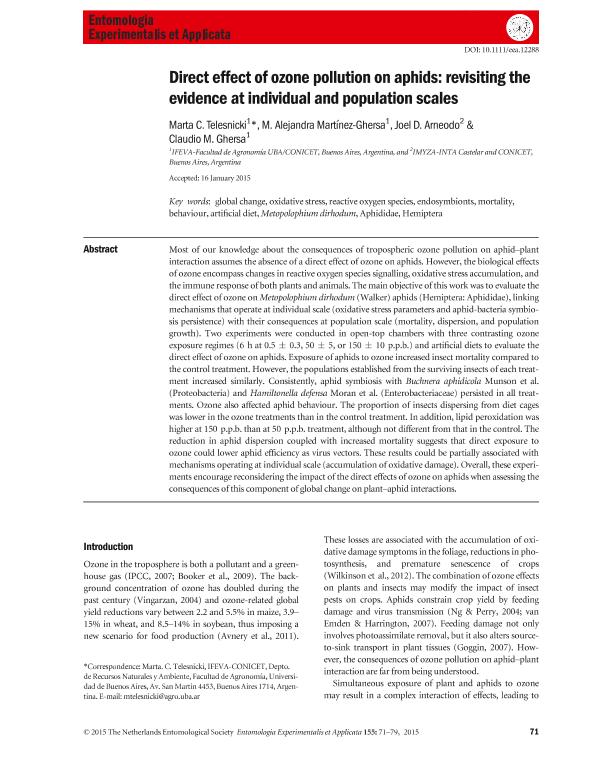Artículo
Direct effect of ozone pollution on aphids: Revisiting the evidence at individual and population scales
Telesnicki, Marta Cecilia ; Martinez-Ghersa, Maria Alejandra
; Martinez-Ghersa, Maria Alejandra ; Arneodo Larochette, Joel Demián
; Arneodo Larochette, Joel Demián ; Ghersa, Claudio Marco
; Ghersa, Claudio Marco
 ; Martinez-Ghersa, Maria Alejandra
; Martinez-Ghersa, Maria Alejandra ; Arneodo Larochette, Joel Demián
; Arneodo Larochette, Joel Demián ; Ghersa, Claudio Marco
; Ghersa, Claudio Marco
Fecha de publicación:
04/2015
Editorial:
Wiley Blackwell Publishing, Inc
Revista:
Entomologia Experimentalis et Applicata
ISSN:
0013-8703
Idioma:
Inglés
Tipo de recurso:
Artículo publicado
Clasificación temática:
Resumen
Most of our knowledge about the consequences of tropospheric ozone pollution on aphid-plant interaction assumes the absence of a direct effect of ozone on aphids. However, the biological effects of ozone encompass changes in reactive oxygen species signalling, oxidative stress accumulation, and the immune response of both plants and animals. The main objective of this work was to evaluate the direct effect of ozone on Metopolophium dirhodum (Walker) aphids (Hemiptera: Aphididae), linking mechanisms that operate at individual scale (oxidative stress parameters and aphid-bacteria symbiosis persistence) with their consequences at population scale (mortality, dispersion, and population growth). Two experiments were conducted in open-top chambers with three contrasting ozone exposure regimes (6 h at 0.5 ± 0.3, 50 ± 5, or 150 ± 10 p.p.b.) and artificial diets to evaluate the direct effect of ozone on aphids. Exposure of aphids to ozone increased insect mortality compared to the control treatment. However, the populations established from the surviving insects of each treatment increased similarly. Consistently, aphid symbiosis with Buchnera aphidicola Munson et al. (Proteobacteria) and Hamiltonella defensa Moran et al. (Enterobacteriaceae) persisted in all treatments. Ozone also affected aphid behaviour. The proportion of insects dispersing from diet cages was lower in the ozone treatments than in the control treatment. In addition, lipid peroxidation was higher at 150 p.p.b. than at 50 p.p.b. treatment, although not different from that in the control. The reduction in aphid dispersion coupled with increased mortality suggests that direct exposure to ozone could lower aphid efficiency as virus vectors. These results could be partially associated with mechanisms operating at individual scale (accumulation of oxidative damage). Overall, these experiments encourage reconsidering the impact of the direct effects of ozone on aphids when assessing the consequences of this component of global change on plant-aphid interactions.
Archivos asociados
Licencia
Identificadores
Colecciones
Articulos(IFEVA)
Articulos de INST.D/INV.FISIOLOGICAS Y ECO.VINCULADAS A L/AGRIC
Articulos de INST.D/INV.FISIOLOGICAS Y ECO.VINCULADAS A L/AGRIC
Citación
Telesnicki, Marta Cecilia; Martinez-Ghersa, Maria Alejandra; Arneodo Larochette, Joel Demián; Ghersa, Claudio Marco; Direct effect of ozone pollution on aphids: Revisiting the evidence at individual and population scales; Wiley Blackwell Publishing, Inc; Entomologia Experimentalis et Applicata; 155; 1; 4-2015; 71-79
Compartir
Altmétricas



